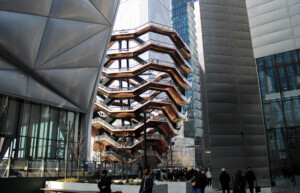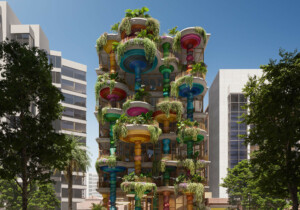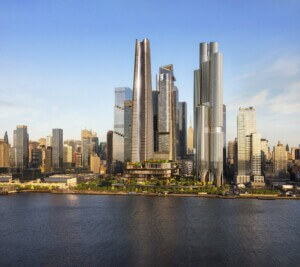The first phase of Manhattan’s $25 billion Hudson Yards development opened to the public on March 15, and with the embargos lifted and first impressions filed, a wide variety of critics have put pen to paper on their Vessel thoughts. The $150 million, 150-foot-tall occupiable sculpture is the centerpiece of Hudson Yards’ first phase and sits at the heart of a Nelson Byrd Woltz–designed plaza.
The Thomas Heatherwick–designed public installation, inspired in part by Indian stepwells, expands from a minimal footprint at the bottom to a 150-foot-wide diameter at the peak. After signing up for free tickets and agreeing to Vessel’s restrictive photo policy, which previously stated that guests would forfeit the rights to any photos or videos taken there, visitors can explore the 154 flights of stairs and 80 landings. Related Companies chairman Stephen Ross, who paid for the structure out of his own pocket, claims that Vessel holds a mile of staircases. For the mobility impaired, Heatherwick Studio has included a curvilinear elevator that stops at three different landings along the sculpture.
The intentions behind the piece have been well stated—the desire to create a monument in Hudson Yards that engages, not overshadows, the surrounding towers, and a “living room” for the public and residents who call the new neighborhood home.
So, what do people think of the 15-story Vessel?
The reviews have been mixed; some saw it as a monument to excess, while others drew comparisons to shawarma, a pinecone, trash can, drinking glasses, and more. Still others juxtaposed the structure’s 360-degree views and position to a panopticon, as Vessel is eminently and intentionally viewable from most places in Hudson Yards.
It should be noted that Related insists that Vessel cost $150 million; the $200 million figure cited in the below articles reportedly accounts for the plaza it sits in as well.
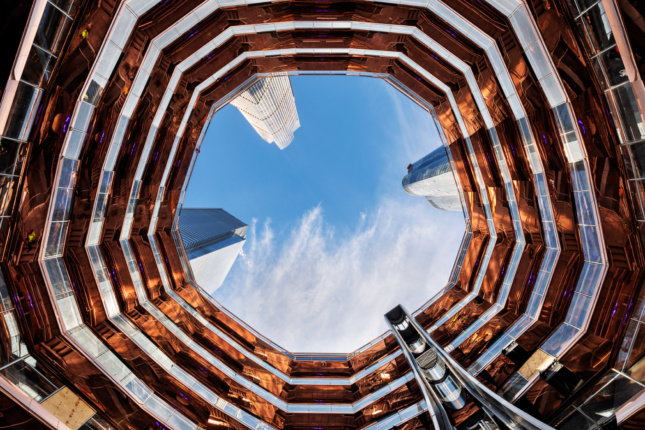
AN‘s Executive Editor Matt Shaw couldn’t help but link Vessel to its larger place and the moneyed circumstances that led to its creation, questioning whether it was spectacle for the sake of spectacle.
“Vessel and its counterpart, The Shed, occupy an important niche in the rich culture of Little Dubai: they serve as the attractors to get tourists to come and play, and thus spend money at retail options. Like the spectacular Dubai Aquarium, Dubai Frame, and man-made islands such as Palm Jumeirah, Vessel acts to bring attention to the place. The High Line is already doing this, but these new spectacles will bring in tourists en masse, possibly so much that this area will be like a cleaner and even less exciting Times Square.
“This centralization of power—via a marriage of government and private interests—gives power to consultants to plan whole districts, as well as ties together Little Dubai and its namesake (and the other countless cities like it). It should not come as a surprise that this is taking place in New York. In fact, it is a very New York phenomenon, as much of this type of culture was shipped from New York’s office towers (literally and metaphorically.)”
Michael Kimmelman didn’t mince words in his review for the NYT.
“It is temporarily called the Vessel. Hoping for public buy-in, its patron, the lead developer of this vast neoliberal Zion, has invited suggestions for a new name.
“Purportedly inspired by ancient Indian stepwells (it’s about as much like them as Skull Mountain at Six Flags Great Adventure is like Chichen Itza) the object—I hesitate to call this a sculpture—is a 150-foot-high, $200 million, latticed, waste-basket-shaped stairway to nowhere, sheathed in a gaudy, copper-cladded steel.”
Justin Davidson had many of the same concerns as Kimmelman, as he recognized that historically stairs have been used as gathering places throughout New York City, but that ultimately Vessel felt like a staircase to nowhere.
“The advance hype doesn’t prepare you for a structure quite this large, shiny, and extravagantly pointless. Its stainless-steel skin gleams russet like polished copper but won’t weather or lose its gloss. From the beginning, Ross declared his desire for an artwork big and splashy enough to focus the whole development. Not a clock or an obelisk—how about a botanical puppy, say, or a Chicago-style shiny kidney bean? Ross wanted something bolder, an artwork he wouldn’t have to warn people off of. Instead, Heatherwick’s piece functions as its own sign: PLEASE CLIMB ON THE SCULPTURE.”
Post writer Zachary Kussin wrote much more enthusiastically about his experience with Vessel.
In an article entitled “Why the Hudson Yards Vessel is $200M worth of glistening glory,” Kussin recounted a grandiose trip to the top of the sculpture. “He’s right. Designed by Thomas Heatherwick and his London-based Heatherwick Studio, Vessel is an interactive artwork made entirely of staircases that make you feel as if you’re in a giant honeycomb, surrounded on all sides by copper-colored steel.”
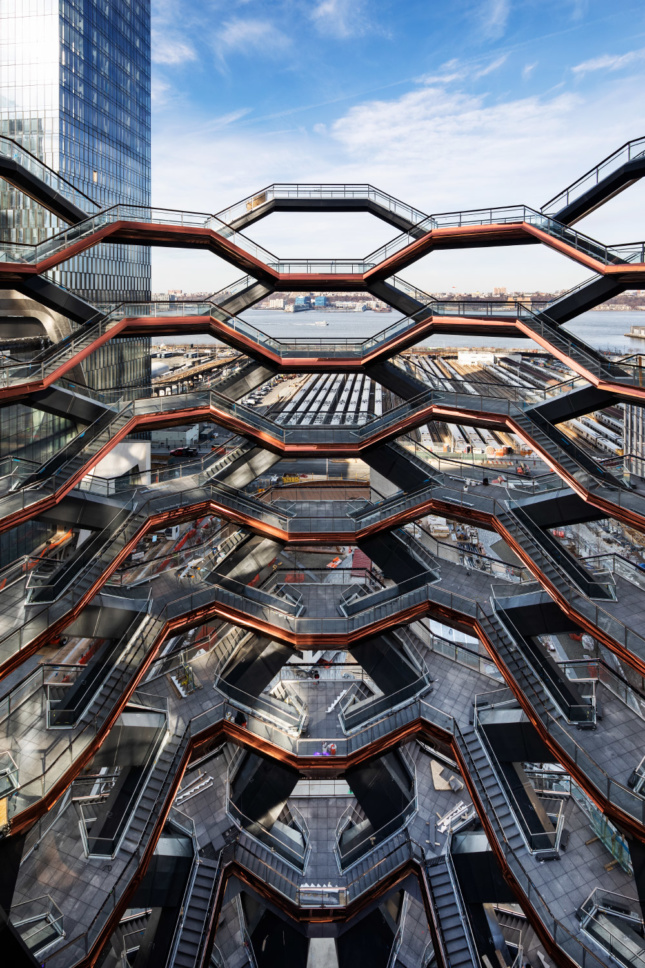
Alexandra Lange, reviewing Hudson Yards for Curbed, was simultaneously dazzled by the physical structure of Vessel, but questioned its promised social utility. She writes that once inside, rather than sparking conversation between climbers, the focus turned towards the piece itself, and an innate awareness of being on Vessel.
“Whatever you call Heatherwick Studio’s Vessel—the wastebasket, the egg-crate, the Escher-brought-to-life, the basketball net, the Great Doner Kebab—it is the opposite of those examples. Not temporary, not cuddly, not delicate. It looks just like its renderings except possibly more perfect. I had mentally assigned it an outer cladding of weathering steel; with everything else so smooth and shiny, surely Vessel would have an industrial flavor? But no—Heatherwick Studio leaned into the fractal nature of its design, and the cladding, copper-colored steel, has a mirror finish like Anish Kapoor’s Bean in Chicago’s Millennium Park, welcoming our irresistible impulse to selfie.”
Kate Wagner’s take on Vessel was, predictably, the most pointed AN was able to find. In “Fuck The Vessel,” Wagner savages Heatherwick’s entire body of work as well as the structure’s premise, writing that Vessel embodied the attitude of Hudson Yards, a utopia for the rich out of the grasp of the other 99 percent.
“It is a Vessel for labor without purpose. The metaphor of the stairway to nowhere precludes a tiring climb to the top where one is expected to spend a few moments with a cell-phone, because at least a valedictory selfie rewards us with the feeling that we wasted time on a giant staircase for something—perhaps something contained in the Vessel. The Vessel valorizes work, the physical work of climbing, all while cloaking it in the rhetoric of enjoyment, as if going up stairs were a particularly ludic activity. The inclusion of an elevator that only stops on certain platforms is ludicrously provocative. The presence of the elevator implies a pressure for the abled-bodied to not use it, since by doing so one bypasses ‘the experience’ of the Vessel, an experience of menial physical labor that aims to achieve the nebulous goal of attaining slightly different views of the city.”
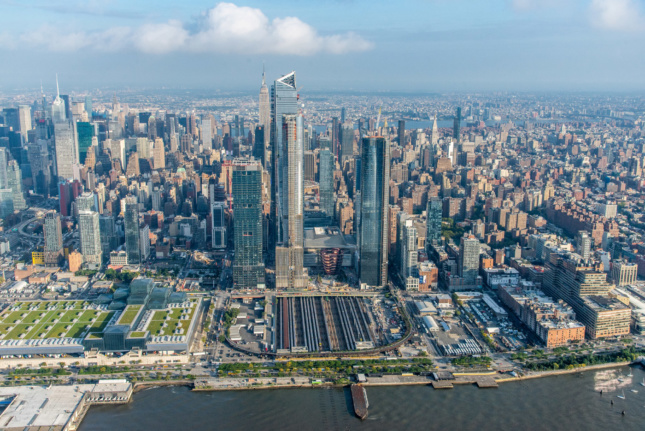
For Thomas Heatherwick’s part, he hasn’t let the criticism bother him. On the opening day of Hudson Yards, The Real Deal was able to snag a brief interview, where the English designer shrugged off the above concerns, saying that all that mattered was whether visitors enjoyed it.
Indeed, it seems that for as many think pieces and social media slams that Vessel has endured over its purpose and aesthetics, and whether it truly belongs in New York, tourists have still been clamoring to climb it.
AN has reached out to Heatherwick Studio for its take on the critical hullabaloo and will update this article accordingly.








